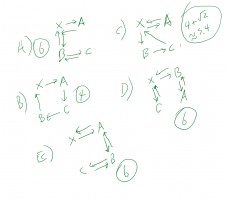Dr.Peterson
Elite Member
- Joined
- Nov 12, 2017
- Messages
- 16,723
I, too, have not taken the time to fully solve it yet."shortest" relative to the other 5 choices? or shortest within the choice A? If it's shortest distance within choice A, there could be infinite number of layouts in 2D space with 4 loci's to consider?
how can i do this without a map? i'm more confused than ever before.
But I beg you to answer my question about context, which I've been wishing for since I first saw the problem. Where did it come from, and why did you expect to be able to solve it? I'm looking for indications of what methods might be expected, other than raw intelligence. (My guess is still that it is essentially an intelligence test, looking for people who can invent their own methods for solving a non-standard problem. If so, then you are free to give up, and perhaps most of us will!)

